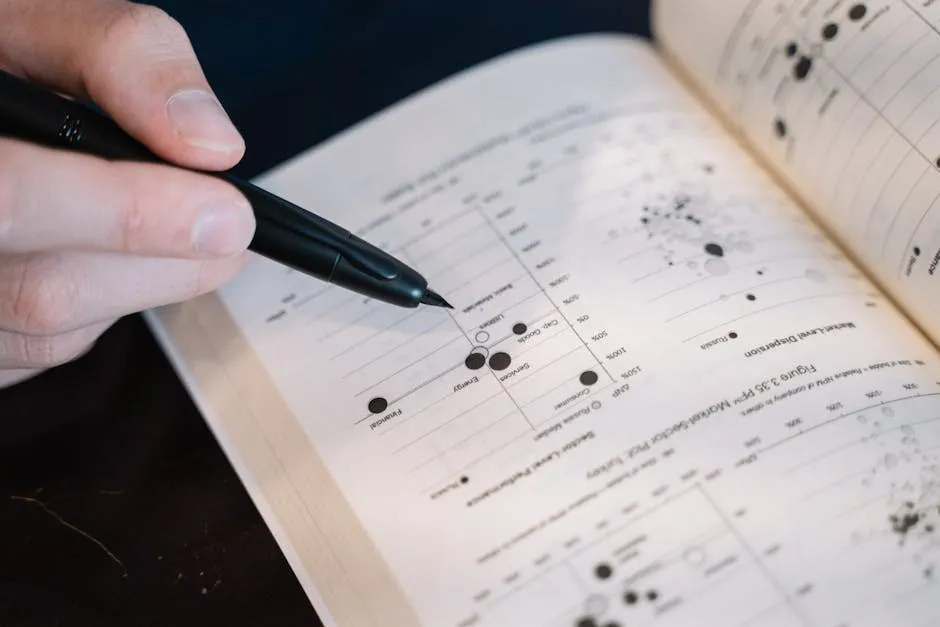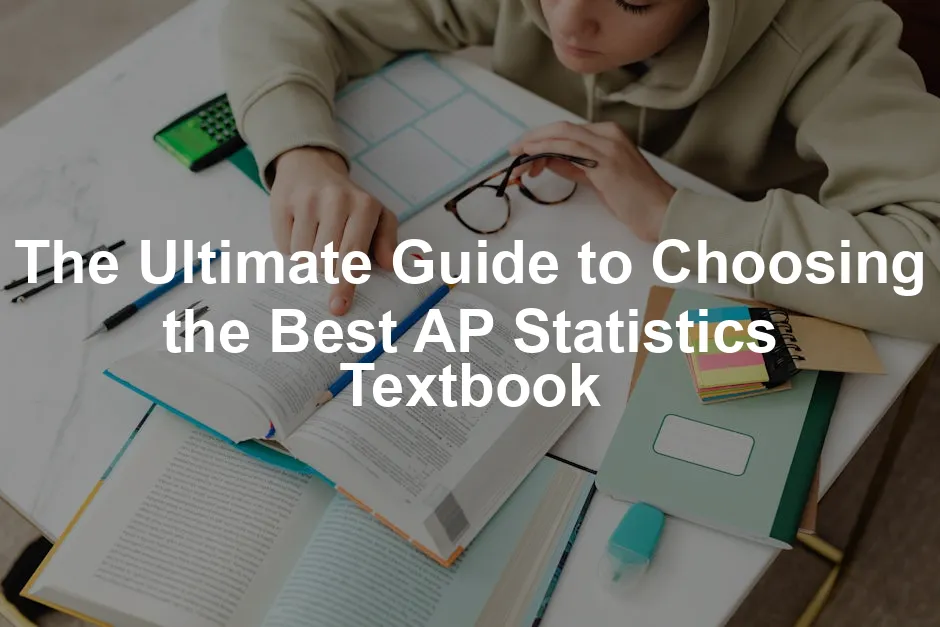Introduction
Choosing the right AP Statistics textbook is as crucial as picking the right toppings for your pizza. Trust me, no one wants pineapple on their stats! A good textbook can make a significant difference in your understanding of statistical concepts and your overall confidence heading into the AP exam. With a multitude of textbooks available, how do you choose the one that fits your learning style and needs?
This guide will help you navigate the sea of AP Statistics textbooks. We’ll examine various options, delve into their features, benefits, and how to select the one that suits you best. Whether you’re a visual learner who loves graphs or an auditory learner who thrives on lectures, there’s a textbook out there for you. So, grab your calculators, and let’s get started!
The AP Statistics exam requires not just rote memorization but a solid grasp of concepts like data analysis, probability, and inference. A well-chosen textbook will serve as your trusty sidekick throughout this learning adventure. Think of it as your personal GPS, guiding you through the twists and turns of statistical methods, sampling distributions, and hypothesis testing.
To enhance your understanding of statistical concepts, consider exploring tips for effective data analysis in economics and statistics.
In this article, we aim to provide a comprehensive overview of the best AP Statistics textbooks available. We’ll highlight what sets each book apart, discuss their unique features, and help you identify the right fit for your study habits. By the end of this guide, you’ll be equipped with all the knowledge you need to make a well-informed decision. So, let’s uncover the best resources to help you conquer the AP Statistics exam!

Why a Good Textbook Matters
Having a quality resource is essential for mastering AP Statistics. A textbook serves as your foundation, providing depth and clarity to complex statistical concepts. When grappling with topics like standard deviation or chi-square tests, a well-written textbook can be your lifeline. It breaks down intricate ideas into digestible pieces, ensuring you don’t feel overwhelmed by the numbers.
A good textbook can also significantly impact your exam preparation. When you have a resource that aligns well with the AP curriculum, it helps you focus on the topics that matter most. You’ll find practice problems that mimic the exam format, giving you a taste of what to expect. This familiarity breeds confidence on exam day and can lead to a better performance overall.
Moreover, the right textbook can inspire a genuine interest in statistics. With engaging examples, real-world applications, and clear explanations, learning becomes less of a chore and more of an exciting challenge. When you’re intrigued by the subject matter, you’ll likely invest more time and effort into your studies.
In summary, a quality textbook is not just a collection of pages; it’s a vital tool in your academic arsenal. It shapes your understanding, boosts your confidence, and ultimately plays a significant role in your success on the AP Statistics exam. So, as you embark on this educational journey, remember: the right textbook can make all the difference!

Main Textbook Options for AP Statistics
The Practice of Statistics (Starnes & Tabor)
Overview
The Practice of Statistics by Daren S. Starnes and Josh Tabor is a leading textbook for AP Statistics. The most recent edition, the Sixth, was released in 2020 and has been updated to align with the latest AP curriculum changes. This textbook combines the authors’ extensive teaching experience and a deep understanding of the AP exam’s requirements to ensure students are well-prepared. It’s designed to cover all essential aspects of statistics, from basic concepts to more complex analyses, making it a comprehensive resource for students aiming for success in their AP Statistics course.
Key Features
This textbook is packed with features that enhance learning. It includes over 1600 problems, ranging from basic exercises to advanced applications, ensuring students have ample practice opportunities. Each chapter is filled with worked examples that break down problems step-by-step, allowing students to grasp challenging concepts. The book also offers exam tips and strategies throughout, preparing students for the types of questions they will encounter on the AP exam. Technology integration is another highlight, with clear instructions for using TI-84 and TI-Nspire calculators, enabling students to perform statistical analyses with ease. The online resources further enrich the learning experience, providing videos and interactive materials to support students in their studies. Don’t forget to check out the Practice of Statistics for a comprehensive understanding!
Pros and Cons
One of the standout strengths of the Practice of Statistics is its comprehensive coverage of topics. The clear, user-friendly approach helps to demystify complex statistical concepts. However, the textbook does come with a hefty price tag, which might deter some students. Additionally, the depth of content can present a learning curve for those new to statistics, potentially overwhelming less confident learners. Overall, it’s a solid investment for students committed to mastering AP Statistics.

Stats: Modeling the World (Bock, Velleman, and De Veaux)
Overview
Stats: Modeling the World, authored by David E. Bock, Paul F. Velleman, and Richard D. De Veaux, is another popular choice among AP Statistics students. This textbook is known for its engaging writing style and the authors’ ability to relate statistical concepts to real-world scenarios. The structure of the book emphasizes modeling and interpretation, which are crucial skills in statistics. The latest edition effectively aligns with the AP curriculum, ensuring students learn what they need to succeed in the course and exam.
Key Features
What sets this textbook apart is its unique approach to statistical education. The authors prioritize real-world applications, illustrating concepts with relatable examples that help students see the relevance of statistics in everyday life. Additionally, the book includes humor and wit, making complex ideas more approachable and enjoyable. Each chapter features numerous exercises to reinforce learning, and the back of the book provides answers to odd-numbered problems, allowing for self-assessment. The text is organized to facilitate understanding, with clear explanations of statistical principles and methods. If you’re looking for a fun read, check out Stats: Modeling the World.
The book also incorporates technology effectively, offering guidance on using calculators and statistical software. This integration ensures students are comfortable with the tools necessary for analyzing data and performing tests. The combination of engaging content and practical applications makes it an excellent choice for students seeking a deeper understanding of statistics.
Pros and Cons
Stats: Modeling the World is celebrated for its readability and engaging style, making it a favorite among students. It excels in presenting statistical concepts in a way that resonates with learners. However, some users note that it may not cover certain advanced topics as thoroughly as other textbooks, potentially leaving gaps for more experienced students. Overall, it’s an excellent resource for those seeking an engaging and practical approach to AP Statistics.

Understandable Statistics (Brase & Brase)
Pros and Cons
The textbook Understandable Statistics by Charles H. Brase and Corrinne P. Brase is a lifeline for many students. It’s like having a friendly guide in the intimidating jungle of numbers and formulas. One of its main benefits is its accessibility. The authors excel at breaking down complex topics into bite-sized, digestible pieces. This makes it ideal for beginners who may feel overwhelmed by statistics. For those looking to enhance their understanding, consider pairing it with Understandable Statistics.
Another strength lies in its engaging tone. The humor sprinkled throughout the text helps to lighten the mood, making learning less of a chore. Additionally, the book provides ample practice problems, allowing students to reinforce their understanding and gain confidence.
However, it isn’t all sunshine and rainbows. Advanced students may find the content a bit basic. The explanations, while clear and friendly, might lack the depth needed for those looking to delve into more complex statistical concepts. For those aiming to tackle higher-level topics, this textbook may not be the best fit.
In summary, Understandable Statistics is perfect for beginners who appreciate a friendly approach. But, for those with a stronger math background, it might leave you craving more challenging material. Finding the right balance is key, and this book offers a solid starting point for many students.

Key Features
When it comes to AP Statistics textbooks, one standout is Advanced High School Statistics by Diez, Cetinkaya-Rundel, and Dorazio. This book is not just your average textbook; it’s a treasure trove of in-depth statistical analysis methods and applications. If you’re ready to dive in, consider visiting Advanced High School Statistics.
For starters, the authors emphasize real-world data analysis. They present statistical concepts through practical examples, making it easier for students to grasp complex topics. Each chapter guides students through various statistical methods, from descriptive statistics to inferential methods. You’ll find a focus on hypothesis testing, regression analysis, and more—perfect for those aiming for a future in statistics or related fields.
The book also excels in its clear explanations. Difficult concepts are broken down into manageable sections, allowing students to build their understanding step by step. With numerous practice problems and detailed solutions, learners can reinforce their knowledge and prepare for the AP exam effectively.
Moreover, the textbook incorporates technology in a meaningful way. Students are introduced to statistical software and graphical tools, which enhance their analytical skills. This tech-savvy approach prepares learners for both the AP exam and future academic pursuits.
In summary, Advanced High School Statistics is a robust choice for those looking to master statistical analysis. Its blend of thorough explanations, practical applications, and technology integration makes it an excellent resource for aspiring statisticians. Whether you’re analyzing data sets or conducting simulations, this textbook provides the tools you need to succeed.

Pros and Cons
Like any educational resource, Advanced High School Statistics has its ups and downs. Let’s break it down.
On the plus side, this textbook is fantastic for students who plan on pursuing future statistics courses. It provides a solid foundation in statistical concepts and methods, giving learners the confidence they need to tackle more advanced studies. The engaging examples help make statistics less intimidating, encouraging a deeper interest in the subject.
However, there’s a flip side. The depth of content might feel overwhelming for some learners, particularly those who are new to statistics. The rigorous approach can be daunting, especially if you’re not well-prepared for the complexity of the material. Some students may find themselves struggling to keep up, which can lead to frustration.
In conclusion, Advanced High School Statistics is an excellent resource for serious students. It prepares you well for future studies but may not suit everyone’s learning pace. Consider your background and comfort level with the subject before diving in!

Resources for Financial Aid
Finding affordable or free textbooks can feel like searching for a unicorn. Luckily, options abound for students needing financial assistance. First off, check your school’s library. Many schools maintain a collection of textbooks, including AP Statistics books. You may find the latest editions ready for checkout.
Next, explore online resources. Websites like OpenStax offer free, peer-reviewed textbooks. They have a range of subjects, including statistics. And who doesn’t love free stuff?
Another option is Project Gutenberg, where you can find various educational materials. It’s like a treasure trove for budget-conscious learners. Additionally, local community colleges sometimes allow high school students to access resources at little to no cost.
Don’t forget about interlibrary loans. If your library doesn’t have the book you need, ask about borrowing it from another library. It’s like having a friend with all the books you want!
Finally, consider joining online marketplaces or forums like Reddit or Facebook groups. Often, students sell their used textbooks at discounted prices. You could snag a deal and help another student out at the same time. And while you’re at it, why not grab a prep book for that extra boost!

Supplementary Resources
Online Resources
When tackling AP Statistics, textbooks are just the beginning. Online platforms like Khan Academy and YouTube can be your best study buddies. Khan Academy offers video tutorials that break down complex concepts into bite-sized pieces. It’s like having a personal tutor, minus the cost.
Reddit has active forums where students share tips, resources, and even study guides. Just search for AP Statistics threads, and you’ll find a wealth of information. Websites like Stat Trek and AP Stats Guy provide additional explanations and practice problems to solidify your understanding. And while you’re at it, consider investing in Statistics for Dummies for an easy-to-understand guide!

Practice Materials
Supplementary materials can dramatically enhance your learning experience. Workbooks and online quizzes are particularly useful. They allow you to practice what you’ve learned, helping to cement those tricky concepts in your brain.
Consider using platforms like Quizlet for flashcards or practice tests. They can make studying feel like a game! Practice problems in your textbook reinforce learning, while online quizzes can give you immediate feedback. This combination ensures you’re well-prepared for the exam. And if you want to keep your study organized, grab a Study Planner Organizer to track your progress!

Conclusion
Choosing the right AP Statistics textbook is no small feat. It’s like picking the perfect avocado—too soft, and you’re in trouble; too hard, and you’ll be waiting forever. A solid textbook provides the foundation you need to understand statistical concepts and tackle the AP exam with confidence.
From traditional textbooks to online resources, the options are plentiful. We’ve covered some of the best choices, highlighting their unique features and benefits. Whether you prefer the engaging style of “Stats: Modeling the World” or the comprehensive nature of “The Practice of Statistics,” there’s something for everyone.
In the end, remember to consider your personal needs and study habits. Are you a visual learner? Look for textbooks with plenty of graphs and illustrations. Prefer hands-on learning? Seek out interactive online resources.
As you embark on this mathematical adventure, make sure to utilize supplementary materials and online resources to bolster your understanding. With the right tools at your disposal, you’ll be well on your way to acing the AP Statistics exam!

FAQs
What should I look for in an AP Statistics textbook?
When selecting an AP Statistics textbook, focus on several key features. First, check if the content aligns with the AP curriculum. A textbook that follows the College Board guidelines will provide the best preparation. Look for clear explanations and plenty of practice problems, as these will help reinforce your learning. Additionally, consider the writing style. Some textbooks are more engaging than others. Choose one that keeps you interested and motivated. Check for supplementary materials, such as online resources or practice tests, which can enhance your study experience.
Is it necessary to have a physical textbook?
The debate between physical and digital textbooks is ongoing. A physical textbook can be easier to annotate and flip through. Many students enjoy having a tangible resource to study from. However, digital formats offer portability and often come with interactive features. Ultimately, it depends on your learning style. If you’re comfortable with screens and appreciate the convenience of e-books, go digital. If you prefer the feel of paper and the ability to scribble notes in margins, stick with a physical book.
Can I use more than one textbook?
Absolutely! Using multiple textbooks can provide a richer understanding of the material. Different authors present concepts in varied ways, which can clarify tricky topics. Many students find that one textbook excels in certain areas while another provides better explanations elsewhere. Using resources like supplementary workbooks or online quizzes alongside your main textbook can also enhance your learning experience.
What additional resources can help me with AP Statistics?
Numerous resources can aid your AP Statistics journey. Websites like Khan Academy and Stat Trek offer video lessons and practice problems. YouTube channels dedicated to math and statistics can also provide valuable insight. Don’t forget about online forums—places like Reddit and Facebook groups where students share tips and resources. Local libraries may offer study guides or access to statistics databases. Lastly, consider hiring a tutor if you need more personalized help. With these tools at your disposal, you’ll be set for success!
Please let us know what you think about our content by leaving a comment down below!
Thank you for reading till here 🙂
All images from Pexels




